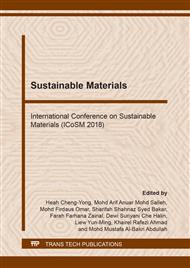p.399
p.410
p.415
p.422
p.433
p.440
p.451
p.462
p.469
Characterisation of Reduction of Iron Ore with Carbonaceous Materials
Abstract:
An investigation on the reduction of iron ore with carbonaceous material as a reductant was carried out at 1550°C. Iron ore was mixed with biochar from palm shell and coke as a reference at C/O molar ratio of 1.0. Characterisation of raw materials was performed using X-ray Fluorescence (XRF), Brunauer–Emmett–Teller (BET), Fourier Transmittance Infrared Spectroscopy (FTIR), X-ray Diffraction (XRD) and Scanning Electron Microscope (SEM-EDX). The samples after reduction were characterised to study the phase transformation and structural properties. The XRD results revealed the iron ore contained hematite as its main composition. After reduction at high temperature, the hematite has been successfully reduced to metallic iron using biochar as a reductant. It was found that the reaction proceeded in a stepwise reduction of iron oxide. The SEM micrographs proved the formation of metallic iron in the sample after reduction at 1550°C. Through characterisation, the biochar from palm shell has physical properties suitable to be an alternative carbon reductant to replace coke.
Info:
Periodical:
Pages:
433-439
Citation:
Online since:
August 2018
Keywords:
Price:
Сopyright:
© 2018 Trans Tech Publications Ltd. All Rights Reserved
Share:
Citation:


